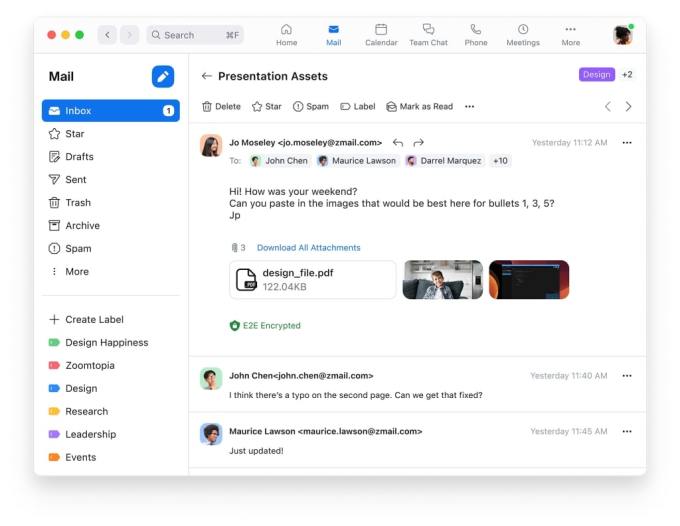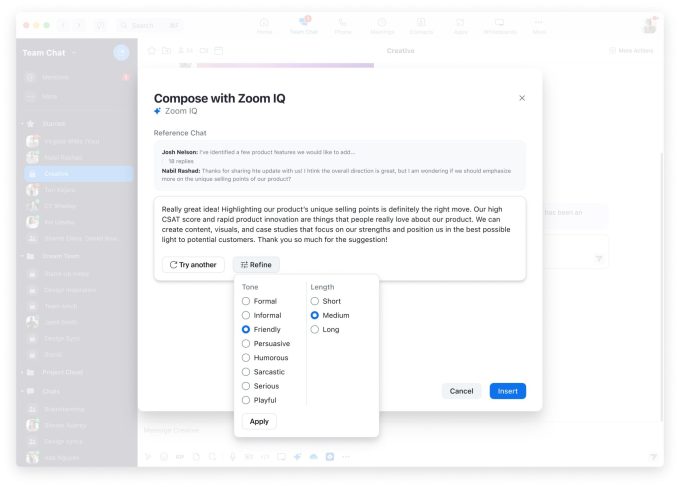Weeks after laying off 1,300 people (or 15% of the staff), Zoom is introducing new features to compete with numerous companies including Slack, Calendly, Google, and Microsoft. These features include AI-powered meeting summaries, prompt-based email responses, and whiteboard generation along with video “Huddles” and a meeting scheduler.
The company wants you to shift more of your work tasks to its tools. To that end, Zoom is opening up its email and calendar clients to everyone. The video conferencing company started testing these tools last year in a big explore area beyond meetings. There are also hosted email and calendar services on offer with end-to-end encryption protection and custom domains for paid users. Companies could use these services as an alternative to Microsoft Exchange and Google Workspace.
These days it’s difficult to spend a few hours without a company announcing generative AI features. Zoom is expanding its Zoom IQ assistant to provide AI-powered summaries and “ask further questions” even when you join a meeting midway. Once the meeting ends, the bot will post a summary to Zoom’s team chat feature. The assistant can also summarize the chat threads in the team chat.
Until now, Zoom IQ had the ability to record highlights, divide a meeting into chapters, and list action items automatically. Last year, the company also launched Zoom IQ for Sales aiming to provide insights from video calls for sales teams.

Zoom Mail client Image Credits: Zoom
Zoom is promising a generative future with Zoom IQ helping users compose chats, emails, and whiteboard sessions, creating meeting agendas. The company is inviting users next month to try these features out with plans for a wider rollout later. The company said it is partnering with OpenAI for the AI features, but it didn’t specify if the partnership includes just API usage or more.

A demo of composing a message with Zoom IQ Image Credits: Zoom
The company introduced some non-AI-focused products as well. It launched Zoom Scheduler in public beta — a Calendly-like tool to share availability to book appointments. Zoom also introduced virtual coworking spaces called Zoom Huddles where people can drop in or drop out at any time. This feature is similar to the Slack Huddles feature, which was introduced in 2021 to have a quick voice or video-based real-time conversations.
Zoom seems to be fighting many battles here. On one hand, it is introducing generative AI features to create emails, meeting agendas, and whiteboards to fight the onslaught of Microsoft and Google. Both of which have announced new generative AI features for workplaces. On the other hand, it is fighting a battle to be a relevant workplace tool beyond meetings that rivals Slack, Calendly, and Otter.
Recently, Slack announced a ChatGPT bot in collaboration with OpenAI. Meanwhile, the transcription tool Otter launched the OtterPilot assistant that automatically summarizes meetings. But that’s not it. Plenty of other meeting-related tools have been launching AI-powered summarization features in different formats.
Zoom’s stock has tanked more than 40% in the last 12 months. The company faced its first quarterly loss of $108 million since 2018 in the fourth quarter results for the 2023 financial year. It expects slowed growth of 1.1% this fiscal year with expected revenue between $4.435 billion to $4.455 billion.
